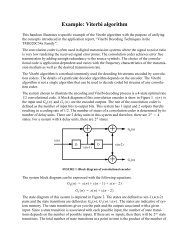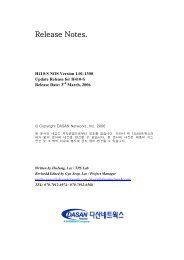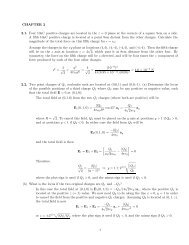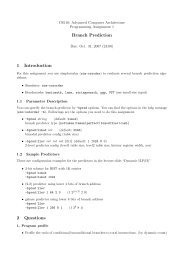"Teaching Smart People How to Learn," by Chris Argyris
"Teaching Smart People How to Learn," by Chris Argyris
"Teaching Smart People How to Learn," by Chris Argyris
- No tags were found...
You also want an ePaper? Increase the reach of your titles
YUMPU automatically turns print PDFs into web optimized ePapers that Google loves.
<strong>Teaching</strong> <strong>Smart</strong> <strong>People</strong> <strong>How</strong> <strong>to</strong> <strong>Learn</strong> · ARGYRIS10performance was so poor that it wasn’t difcult <strong>to</strong> reach a decision.’’ Most of the six hadreceived timely feedback about their problems. And in the two cases where people hadnot, the reason was that they had never taken the responsibility <strong>to</strong> seek out evaluations—and, indeed, had actively avoided them. ‘‘If you have any data <strong>to</strong> the contrary,’’ the CEOadded, ‘‘let’s talk about it.’’Were the six asked <strong>to</strong> leave for economic reasons? No, said the CEO. ‘‘We have morework than we can do, and letting professionals go is extremely costly for us. Do any ofyou have any information <strong>to</strong> the contrary?’’As <strong>to</strong> the company being antilearning, in fact, the entire evaluation process was designed<strong>to</strong> encourage learning. When a professional is performing below the minimumlevel, the CEO explained, ‘‘we jointly design remedial experiences with the individual.Then we look for signs of improvement. In these cases, either the professionals werereluctant <strong>to</strong> take on such assignments or they repeatedly failed when they did. Again, ifyou have information or evidence <strong>to</strong> the contrary, I’d like <strong>to</strong> hear about it.’’The CEO concluded: ‘‘It’s regrettable, but sometimes we make mistakes and hire thewrong people. If individuals don’t produce and repeatedly prove themselves unable <strong>to</strong>improve, we don’t know what else <strong>to</strong> do except dismiss them. It’s just not fair <strong>to</strong> keeppoorly performing individuals in the company. They earn an unfair share of the nancialrewards.’’Instead of responding with data of their own, the professionals simply repeated theiraccusations but in ways that consistently contradicted their claims. They said that a genuinelyfair evaluation process would contain clear and documentable data about performance—butthey were unable <strong>to</strong> provide rsthand examples of the unfairness that theyimplied colored the evaluation of the six dismissed employees. They argued that peopleshouldn’t be judged <strong>by</strong> inferences unconnected <strong>to</strong> their actual performance—but theyjudge management in precisely this way. They insisted that management de ne clear,objective, and unambiguous performance standards—but they argued that any humanesystem would take in<strong>to</strong> account that the performance of a professional cannot be preciselymeasured. Finally, they presented themselves as champions of learning—but they neverproposed any criteria for assessing whether an individual might be unable <strong>to</strong> learn.In short, the professionals seemed <strong>to</strong> hold management <strong>to</strong> a different level of performancethan they held themselves. In their conversation at the meetings, they used manyof the features of ineffective evaluation that they condemned—the absence of concretedata, for example, and the dependence on a circular logic of ‘‘heads we win, tails youlose.’’ It is as if they were saying, ‘‘Here are the features of a fair performance-evaluationsystem. You should abide <strong>by</strong> them. But we don’t have <strong>to</strong> when we are evaluating you.’’Indeed, if we were <strong>to</strong> explain the professionals’ behavior <strong>by</strong> articulating rules thatwould have <strong>to</strong> be in their heads in order for them <strong>to</strong> act the way they did, the rules wouldlook something like this:1. When criticizing the company, state your criticism in ways that you believe arevalid—but also in ways that prevent others from deciding for themselves whetheryour claim <strong>to</strong> validity is correct.2. When asked <strong>to</strong> illustrate your criticisms, don’t include any data that others could use<strong>to</strong> decide for themselves whether the illustrations are valid.3. State your conclusions in ways that disguise their logical implications. If others poin<strong>to</strong>ut those implications <strong>to</strong> you, deny them.Of course, when such rules were described <strong>to</strong> the professionals, they found themabhorrent. It was inconceivable that these rules might explain their actions. And yet indefending themselves against this observation, they almost always inadvertently con-rmed the rules.<strong>Learn</strong>ing <strong>How</strong> <strong>to</strong> Reason ProductivelyIf defensive reasoning is as widespread as I believe, then focusing on an individual’sattitudes or commitment is never enough <strong>to</strong> produce real change. And as the previousexample illustrates, neither is creating new organizational structures or systems. The problemis that even when people are genuinely committed <strong>to</strong> improving their performanceand management has changed its structures in order <strong>to</strong> encourage the ‘‘right’’ kind ofVolume 4, Number 2, REFLECTIONS




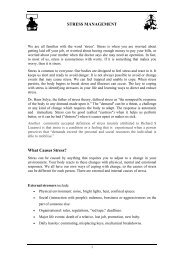

![Finale 2006 - [autumn leaves.MUS]](https://img.yumpu.com/46046993/1/184x260/finale-2006-autumn-leavesmus.jpg?quality=85)

